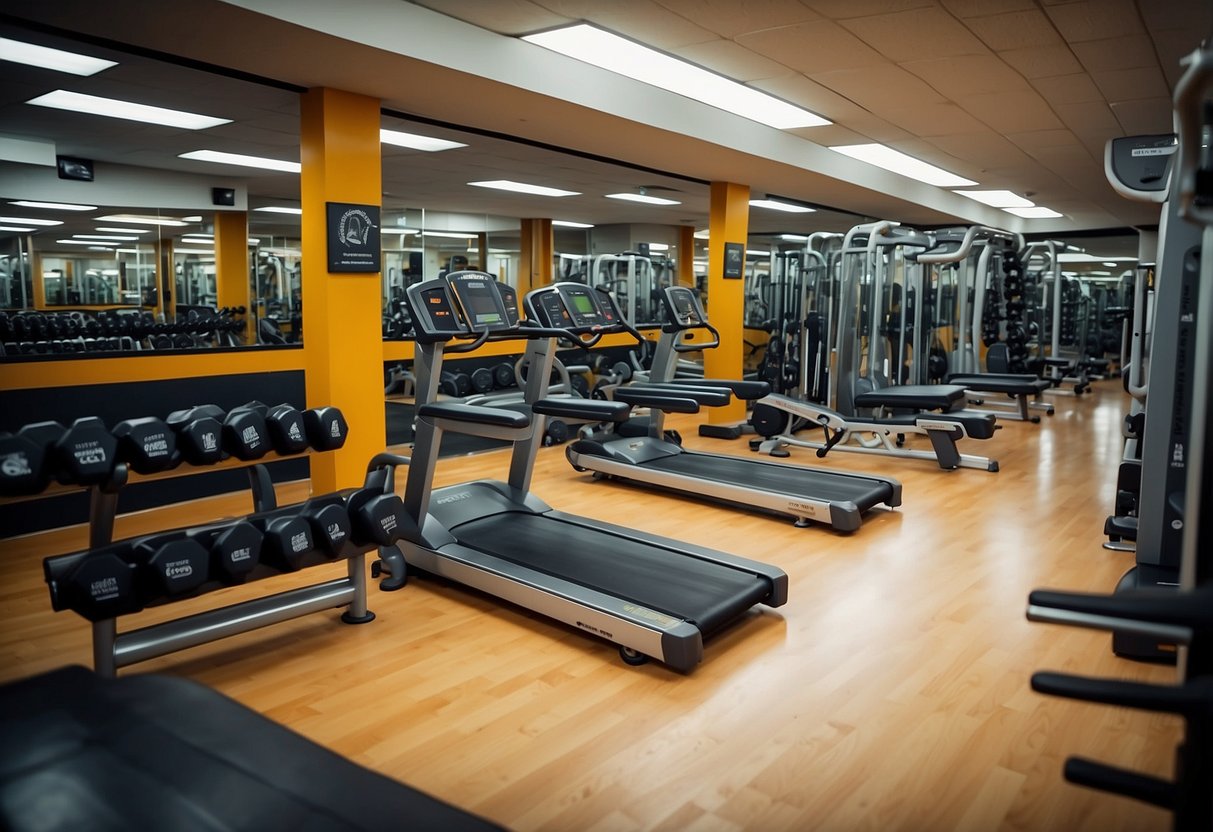Starting a workout routine might seem overwhelming, but don’t worry—you can do it. There are some basic rules and tips that can help you get the most out of your exercise sessions. Understanding these essential guidelines can make your workouts more effective and enjoyable.

When you know what to focus on, exercise can quickly become a part of your daily life. You’ll find yourself reaching your fitness goals faster and staying motivated along the way. Whether you’re a beginner or looking to refine your current routine, these tips will provide the direction you need.
Always warm up properly
Warming up before exercise is crucial to prepare your body for physical activity. Start with a simple exercise like marching on the spot for three minutes. This gets your heart pumping and muscles ready for more intense movements.
Dynamic stretches are a great addition. For example, try lunges with arm circles to engage multiple muscle groups. This type of movement helps improve flexibility and reduces the risk of injury.
Consider doing lighter variations of the exercises you’ll perform in your workout. If you plan to do push-ups, start with push-ups against a countertop. This helps your muscles adjust gradually to the upcoming strain.
Incorporate heel digs as well. Aim to do 60 heel digs in 60 seconds. This movement can activate your leg muscles and improve your overall range of motion. Warm-up routines like this ensure your body is ready for more intense activities.
Maintain Proper Form
Keeping proper form during workouts is essential. When lifting weights, breathe out as you lift and breathe in as you lower. This helps maintain control and stability.
Balance your routine by working all major muscle groups. This includes your abdomen, hips, legs, chest, back, shoulders, and arms. Strengthen opposing muscles to avoid imbalances.
While running, keep your arms relaxed and your hands open. Pretend you’re holding an egg in each hand to stay loose. This prevents tension from moving up to your shoulders and neck.
Maintain good posture. Engage your core and keep your gaze forward. Avoid tilting your head down or slumping your shoulders. Keeping your chest broad and lifted can make a big difference.
Focus on your form and make minor adjustments as needed. This will help you stay injury-free and get the most out of your workouts.
Stay Hydrated
Staying hydrated is crucial when you exercise. Before your workout, aim to drink around 450ml of water two to four hours beforehand. This helps ensure your body is ready for the effort ahead.
During your workout, keep a water bottle handy. For every hour of exercise, try to drink about 500ml of water. If you’re doing a high-intensity workout like a long-distance run, you may need more fluids.
After working out, rehydrate to replace lost fluids. A good rule is to weigh yourself before and after. If you’ve lost weight, drink enough water to make up for the loss. Remember, staying hydrated can significantly boost your performance and recovery. For more detailed guidance, check out this advice on hydration during exercise.
Listen to your body
Listening to your body is crucial during workouts. It prevents injuries and helps you get the best results.
Pay attention to how your muscles feel. If you notice sharp pain, stop immediately. This could be a sign of an injury.
Remember to adjust your workout intensity. If you’re feeling overly tired or sore, it might be time to take a rest day. Embracing rest days is essential for recovery.
Reflecting on your body’s reactions after a session can give valuable insights. Do you feel energised or exhausted? Adjust your routine based on these signals.
For more tips, visit Peloton.
Plan your workouts

Start by setting clear goals. Do you want to build muscle, lose fat, or just stay active? Knowing what you aim to achieve helps make your workout plan effective.
Next, decide how many days a week you can realistically commit to exercise. It’s better to start with fewer days and gradually increase as you get comfortable.
Choose exercises that target major muscle groups. Include a mix of strength training and cardio. This keeps your routine balanced and ensures you work out your entire body.
Don’t forget to schedule rest days. Your muscles need time to recover and grow stronger. Aim for at least one rest day per week.
Write down your plan. Seeing it on paper, or on your phone, adds motivation. You can use sticky notes on your bathroom mirror as a reminder of your weekly targets (Peloton).
Remember to be flexible with your plan. If you find the equipment is taken, have a backup exercise ready. This keeps your workout on track without wasting time (SELF).
Set achievable goals
Setting realistic fitness goals is crucial for staying motivated. Start by identifying what you want to achieve in a clear, specific way. For instance, instead of saying you want to get fit, aim for “running 5 kilometres within 3 months.”
Use the SMART framework to make your goals clear and measurable. Your goals should be Specific, Measurable, Achievable, Relevant, and Time-bound. This method helps you track your progress.
It’s also important to be flexible. If you find that your initial goal is too hard or too easy, adjust it. Giving yourself permission to change your goals as you progress can keep you motivated and prevent burnout.
Incorporate a mix of exercise types to keep your routine interesting. Combine cardiovascular activities like jogging or swimming with strength training exercises such as squats and push-ups. This not only makes workouts more enjoyable but also improves your overall fitness.
Track your progress
Tracking your progress is crucial for staying motivated and achieving your fitness goals. One simple method is to take progress photos. These pictures show how your body changes over time. Compare them every few weeks to see the difference.
Another easy way to track changes is to focus on how your clothes fit. Notice if your gym shorts feel looser or if you need smaller sizes.
Use a fitness journal or app to record your workouts. Write down the exercises you performed, sets, reps, and weights used. This helps you see improvements and stay on track with your routine.
Rest and Recover
Rest and recovery are essential for effective workouts. Your muscles need time to repair, rebuild, and strengthen. If you don’t rest, you risk injury and burnout. It’s not about being lazy; it’s about being smart with your training.
Experts suggest resting each muscle group for 48-72 hours after a tough workout. This helps you gain maximum strength and avoid fatigue. During this time, you can try active recovery like walking, light stretching, or yoga.
Hydrating is crucial too. Drink 1.5 litres for every kilogram of body weight lost during exercise. Staying hydrated helps your muscles recover faster and keeps you feeling energised. Plus, it can prevent cramps and stiffness.
Incorporating fun activities on rest days, like hiking or swimming, can help keep you motivated. These activities are gentle on your body but still keep you active. They also provide a mental break from your usual routine.
Don’t underestimate the power of sleep. Aim for 7-9 hours a night to let your body fully recover. Good sleep helps repair muscles, boosts mood, and improves overall performance in your workouts.
Vary Your Routines
Varying your workout routines is key to avoiding a plateau in your progress. When you do the same exercises all the time, your body gets used to them. This can slow down your results.
Switching up your exercises keeps things interesting and challenges your body in new ways. Try adding different kinds of cardio, strength training, and stretching to your routine.
You can also switch up the intensity of your workouts. Some days, go all out with high-intensity exercises; other days, take it slower. This variety can help you stay motivated and keep your body guessing.
Focus on nutrition
You need to pay attention to nutrition if you want to maximise your workouts. Eating the right food can make a big difference in how you feel and perform. Start with whole-grain cereals or bread, paired with low-fat milk. These provide a steady source of energy.
Fruit and yoghurt are great choices too. For instance, having a banana or a serving of yoghurt can give you that quick boost you need before working out.
Also, remember to stay hydrated. Drinking plain water or eating water-rich foods like fruit is essential. Make sure you have a balanced meal a couple of hours before exercising. This helps your muscles recover better. After a strenuous workout, you might want to consume carbohydrates quickly. This could be in the form of a fruit smoothie or a sports drink.
For those long endurance workouts, consider products like carb bars, gels, and chews. They’re designed to keep your energy levels up. Avoid trying new foods right before a workout to prevent stomach issues.
Thinking about taking creatine? If you’ve been using it for a while, 2-5 grams a day should work. Just starting? Load your muscles with 20-30 grams per day for 4-5 days to see the best results.
Take charge of your nutrition to see better results in your workouts!
Fundamental Workout Rules
Following certain workout rules can significantly improve the effectiveness of your fitness routine. There are three key areas to focus on: setting clear goals, maintaining consistency, and ensuring proper form.
Understand Your Goals
Before diving into any workout regimen, it’s crucial to know what you’re aiming for. Are you looking to build muscle, lose weight, increase endurance, or improve flexibility? Each goal requires different types of exercises and intensity levels.
Set specific, measurable, achievable, relevant, and time-bound (SMART) goals. For example, if your goal is to build muscle, aim to lift a certain amount of weight within a specific timeframe. Tracking your progress will help you stay motivated and make necessary adjustments.
Without clear goals, you might end up frustrated or even risk injury. So take the time to figure this out before you start. This will allow you to tailor your workouts to meet your objectives more effectively.
Consistency is Key
Consistency is one of the most important factors in achieving fitness success. It’s better to work out a few times a week regularly than to have sporadic, intense sessions infrequently. Choose a schedule that fits your lifestyle to make exercising a habit rather than a chore.
Whether it’s three days a week or six, pick a routine you can stick with. Regular workouts help build momentum and make it easier to progress. For sustained results, your routine should be balanced, including strength, cardio, and flexibility exercises.
Life can get busy, but you need to prioritise your workouts. Even on days when you’re tired, a short session is better than skipping it altogether. Keeping up morale is easier when you see gradual, steady improvement over time.
Focus on Proper Form
Proper form is essential to avoid injury and get the most out of your exercises. Watching yourself in a mirror or working with a trainer can help ensure you’re doing it right. Incorrect form can lead to injuries that might sideline you for weeks.
Start with lighter weights or simpler versions of exercises to master the movements first. Focus on slow, controlled motions rather than lifting heavy weights too soon. Engage the correct muscle groups and maintain a strong core to stabilise your body.
Remember that it’s not about looking impressive; it’s about making substantial, safe progress. Pay attention to alignment and posture for every exercise, whether it’s a squat, deadlift, or bench press. Good form will maximise your gains and keep you on track towards your goals.
Tips for Optimising Your Workout
To get the most out of your workouts, it’s essential to focus on several key aspects. These include properly warming up and cooling down, monitoring your progress regularly, and staying well-hydrated throughout your exercise routine.
Warm Up and Cool Down
Before diving into any intense workout, it’s crucial to start with a proper warm-up. This prepares your muscles and reduces the risk of injury. Dynamic stretching, such as leg swings and arm circles, can be very effective. Five to ten minutes of light cardio, like jogging in place, can also help get your heart rate up.
After your workout, cooling down helps your body transition back to rest. Static stretching is recommended at this stage. Hold each stretch for 20-30 seconds, focusing on the major muscle groups you worked out. Cooling down can help with muscle recovery and reduce soreness.
Monitor Your Progress
Keeping track of your progress is essential for staying motivated and seeing improvement. Use a workout log or a fitness app to record details like weight lifted, repetitions, and the type of exercise. Regularly reviewing this data helps you spot trends and make necessary adjustments.
It’s also beneficial to set specific, measurable goals. For instance, aim to increase your running distance by a kilometre after a month. Regular check-ins, such as monthly fitness assessments, can keep you on track and help you celebrate your achievements.
Stay Hydrated
Water plays a vital role in your fitness and overall health. It’s important to drink water before, during, and after your workout. Aim for at least half a litre of water an hour before exercising and take sips throughout your session to stay hydrated.
Post-workout hydration is equally crucial. Replenishing lost fluids helps with recovery and reduces fatigue. Adding a pinch of salt to your water can replace lost electrolytes if you’ve had a particularly intense session. Staying hydrated helps maintain energy levels and improves performance.
Balancing Workout Intensity
Balancing workout intensity is essential to avoid burnout and injuries, while still making progress. This section covers how to effectively manage intensity by incorporating rest days, gradually increasing effort, and listening to your body.
Incorporate Rest Days
It’s important to include rest days in your workout routine. These days allow your muscles to repair and rebuild, which helps to increase strength and endurance over time. Rest days also prevent overtraining, which can lead to injuries and fatigue.
Make sure to schedule rest days after intense workouts. If you’ve had a tough session focusing on heavy weights or high-intensity interval training (HIIT), giving your body a break helps it recover properly.
Listen to your body’s signs. If you’re feeling more tired than usual, or muscle soreness lasts longer than expected, an extra rest day can be beneficial.
Active rest days can be effective, where you engage in light activities like walking or stretching. This keeps your body active without putting too much strain on it. Balancing between intense workouts and rest days ensures long-term progress and health.
Gradually Increase Intensity
To continuously improve, it’s important to gradually increase workout intensity. starting too hard can lead to injuries or burnout.
Begin with a manageable pace. If you’re new to exercising, start with light to moderate intensity workouts. This helps your body adapt and build a foundation of strength and endurance.
Use the principle of progressive overload. Gradually increase weights, reps, or intensity in small increments. For example, add a bit more weight to your lifts or increase your running distance slightly each week.
Monitor your progress. Keep a workout journal or use an app to track improvements. This can help you see patterns in your performance and adjust your workouts accordingly.
Stay consistent. Don’t rush the process. Gradual changes can lead to sustainable growth and help prevent plateaus in your fitness journey.
Listen to Your Body
Your body gives you signals that can help you adjust your training intensity. It’s crucial to pay attention to these cues to avoid overtraining and injuries.
Signs of overtraining include prolonged muscle soreness, fatigue, and a decrease in performance. If you notice these, it may be time to dial back intensity or take additional rest days.
Incorporate regular check-ins with yourself. Ask how you’re feeling physically and mentally before starting your workouts. Being mindful of your energy levels can inform whether you should push harder or take it easy.
Adjust based on feedback. If an exercise feels particularly difficult one day, don’t force it. Opt for a lighter version or a different exercise to prevent strain.
Hydration and nutrition play a role, too. Ensure you’re fuelling your body appropriately to support your workouts. By listening to your body, you can maintain a balanced and effective workout routine.







